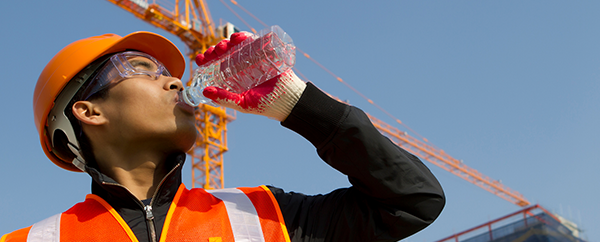3 ways to help your employees beat workplace heat illness
As our summer heats up, so will the risk of workplace heat illness. Last year most of the nation experienced extreme heat, and this summer looks to be no different. Now’s a good time to remind your supervisors and their teams to watch out for symptoms of heat stress.
Workers at risk of heat illness include not only outdoor workers such as farmers or construction employees, but also anyone in hot environments such as firefighters, bakery workers, boiler room workers, factory workers and others. Employees at greater risk of workplace heat stress include those who are overweight or 65 years of age or older, have heart disease or high blood pressure, or take medications that may be affected by extreme heat.
Related: Best practices for reporting workplace incidents
Heat can also increase the risk of injuries in workers, as it may result in sweaty palms, fogged-up safety glasses and dizziness. Burns may occur as a result of accidental contact with hot surfaces or steam. Whether it’s minor heat stress or a more severe heat stroke that results in a workers’ compensation claim, watch for the signs and know what to do.
Workplace heat illness: Know the signs
From a minor but bothersome heat rash to severe heat stroke or Rhabdomyolysis (muscle death from over-exhaustion), supervisors who oversee outdoor workers need to be aware of the signs of various workplace heat diseases and know what to do if an episode occurs, to help mitigate heat illness work comp claims.
- Heat stroke is the most serious heat-related illness and requires immediate medical attention. It occurs when the body becomes unable to control its temperature. The body’s temperature rises rapidly, the sweating mechanism fails, and the body is unable to cool down. When heat stroke occurs, the body temperature can rise to 106°F or higher within 10 to 15 minutes.
Symptoms: confusion, fainting, seizures, very high body temperature and hot, dry skin or profuse sweating.
First aid: CALL 911 if a coworker shows signs of heat stroke. Move the worker to a cooler area and remove outer clothing. Cool the worker quickly with cold water with either wet cloths or by soaking their clothing. Head, neck, armpits and groin are key areas to cool first. Circulate air around the worker to speed cooling. - Heat exhaustion is the body’s response to an excessive loss of the water and salt, usually through excessive sweating.
Symptoms: headache, nausea, dizziness, weakness, thirst and heavy sweating.
First aid: Move the worker to a cooler area and give cool liquids to drink. Remove unnecessary clothing including shoes and socks. Use cold compresses or have him wash his head, face and neck with cold water. In extreme cases, take the worker to a clinic or emergency room for evaluation, or call 911. - Rhabdomyolysis is caused by heat stress and prolonged physical exertion, resulting in the rapid breakdown and death of a muscle. As muscle tissue dies, it can release harmful substances into the bloodstream that can cause irregular heart beat and seizure or damage the kidneys.
Symptoms: Sometimes there are none. At other times, there will be muscle cramps and pain, weakness, abnormally dark urine.
First aid: Stop activity; drink water. Seek immediate care at the nearest medical facility, asking to be checked for rhabdomyolysis. - Heat syncope is a fainting or dizzy spell that usually occurs with prolonged standing or sudden rising from a sitting position.
Symptoms: Fainting (short duration), dizziness or light-headedness.
First aid: The worker should sit or lie down in a cool place and slowly drink water, clear juice or a sports drink. - Heat cramps typically affect workers who sweat a lot during strenuous activity, which depletes the body’s salt and moisture levels, causing the cramps.
Symptoms: Muscle cramps, spasms or pain in the abdomen, arms or legs.
First aid: Drink water and have a snack and/or a sports drink (carbohydrate-electrolyte replacement liquid) every 15-20 minutes. Do not take salt tablets. Get medical help if the worker has heart problems, is on a low-sodium diet or if cramps don’t subside within an hour.
Related: Workplace Safety Incentives: Stop Accidents Before They Start
Safety measures to prevent workplace heat illness and work comp claims
Remember these three words: Water. Rest. Shade. Limiting time in the heat, drinking water often and taking breaks can help prevent heat illness, whether a minor occurrence or one necessitating a workers’ compensation claim.
Gradually building up to heavy work in hot conditions is important, because it helps workers build tolerance to the heat. Employers should take steps that help workers become acclimated, especially those new to working in the heat or who’ve been away from work for a week or more. Gradually increase workloads and allow more frequent breaks during the first week of work.
Workers should wear clothing that protects from the sun but allows airflow to the body. Head and eye protection should always be used outdoors. They should also drink water continually – every 15 minutes, whether thirsty or not. The body can produce as much as 2-3 gallons of sweat a day, so workers need to drink 3-4 cups of water every hour, starting just before their shift starts.
Enact a heat illness prevention program
Prevention of heat stress in workers is important. Employers are responsible not only to make the work environment as safe as possible, but also provide training to workers so they understand what heat stress is, how it affects their health and safety, and how it can be prevented. It’s a good idea to include advice from your workers’ compensation medical provider when creating a plan.
A prevention plan should consider:
- Identifying the hot environment and conditions, whether indoors or outdoors, including checking weather conditions for high heat index
- Modifying work schedules according to the heat, such as rescheduling non-essential outdoor work for lower heat days; scheduling more physically demanding work during the coolest hours; rotating workers; increasing breaks during high heat
- Providing drinking water and shade
- Ensuring work breaks and employee acclimatization to the heat
- Training employees and supervisors on prevention, symptoms and first aid
- Encouraging workers to watch out for symptoms in their coworkers by using the buddy system
- Providing first aid equipment
- Emergency planning and response training, such as how to contact emergency help, how long it will take emergency help to arrive and appropriate first aid measures until help arrives
Sources:
Heat Stress – Heat Related Illness
Working in the Summer Heat
Heat Illness Can Be Deadly
OSHA: Protecting workers from the effects of heat
This blogpost was originally published on Arrowhead’s Tribal blog. Content has been modified and updated to better fit the needs of ACM’s clients.

